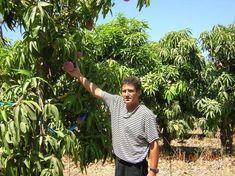
After 15 years of research and development at The Volcani Center in Israel, growers point to two mangoes ñ Shelly and Tango Mango, as the varieties that can be relied upon to strengthen the position of Israeli mangoes on the European markets.
Dr Uri Lavi, of the Department of Fruit Tree Breeding and Genetics at The Volcani Center, south of Tel Aviv, said that mango cultivation in the western world is limited to just a few varieties, led by the two most popular ñ Tommy Atkins and Keitt.
“Since the cultivation and export of mango is becoming an important item on Israel's agriculture agenda ñ for local consumption and especially for export ñ it was essential that Israel would launch a breeding projects, for several reasons,” said Lavi.
He explained that the breeding plan is aimed at achieving two purposes. The first is to overcome several recognised shortcomings of the two leading varieties on the market, such as Tommy Atkins' problem of taste and quality, despite its very attractive exterior appearance; and conversely the green exterior and over-sizing tendency of Keitt, which is a fruit renowned for its eating quality.
“Israel is now able to come to market with two exclusive varieties. In view of the tough competition on the European mango and sub-tropical fruit market, the target was to present mangoes that no other suppliers have,” he said.
“Consumers prefer tasty, attractive looking fruit that maintains its aroma and quality longer than existing varieties. For the past 15 years we endeavoured to identify promising types, until some 10 years ago, we pinpointed Tango Mango and Shelly as the most promising ones.”
The experiments were conducted in a 10,000 mango tree orchard at The Volcani Center and in other parts of the country, notably in the Jordan Valley region, which is the main cultivation area of Israeli mangoes. The aim was to select new cultivars with better performances than the commercial types already on the market.
Shelly is a cross between Tommy Atkins and Keitt. The original Shelly tree (see top photo, right) is small, but started to bear fruit in its third year after planting. Shelly, Dr Lavi said, “is a late ripening cultivar, weighing about 500 grams. Its appearance is reminiscent of a big apple, round with no beak or sinus. Its harvest season runs from September to mid-November. The mature fruit is orange-hued with a red blush. The flesh is juicy, firm and fibreless, with mild flavour and is slightly sweet. An important characteristic of Shelly is that at room temperature of 22-25°C, the fruit remains firm and attractive-looking up to 30 days after harvest.”
Whereas Shelly is a late ripening fruit, Tango Mango is an early-ripening cultivar. This fruit has the advantage of long shelf-life, excellent taste, and brilliant orange blushed with red exterior colours. The interior texture is juicy, tender and fibreless, with a mild sweet and sour flavour. A relatively minor problem connected with Tango Mango is its large size in plantations in the Inner Valleys surrounding the Lake of Galilee, now the main cultivation areas of Israel's mangoes.
Lavi explained that Tango Mango's harvest, mainly from plantations in the Coastal Plain, is mid-August to mid-September. In addition to coming to market with two new and unique mango varieties, exporters say that extending the period of export “is another advantage on the markets”.
This year's mango yield in Israel set a record of 35,000 tonnes, double the quantity attained last year. Total export volume by all exporters is estimated at nearly 10,000t, of which Agrexco, according to sources at the company, will export 6,000t.
Trade sources characterised this season as “relatively reasonable,” while pointing to the low prices attained for Tommy Atkins compared with the success of Shelly and Tango Mango on the European markets.



